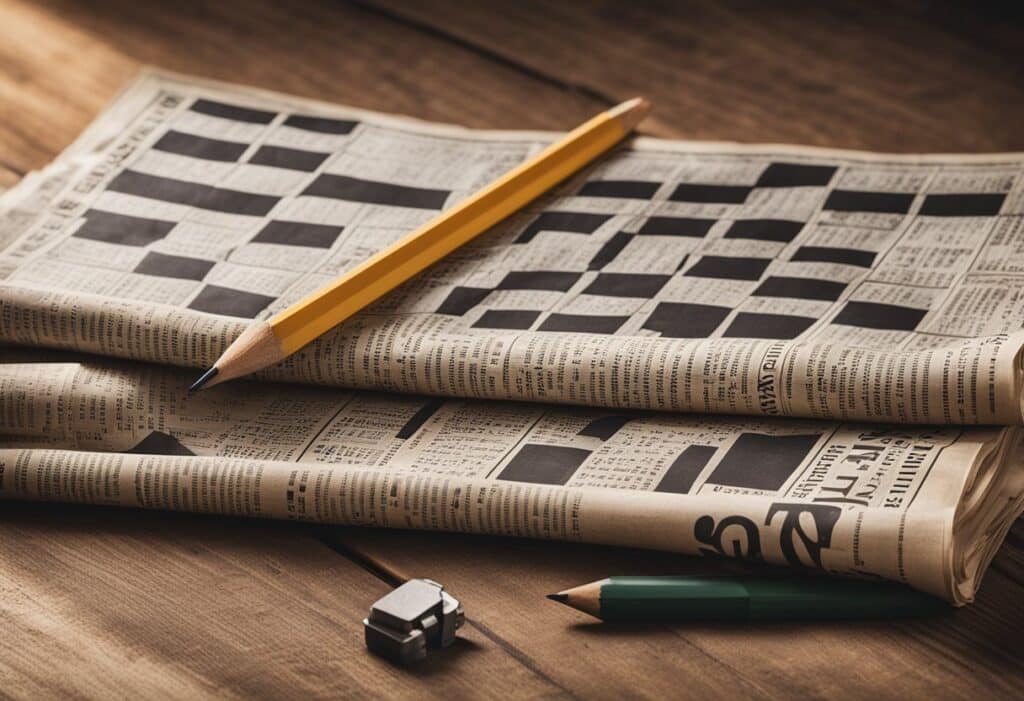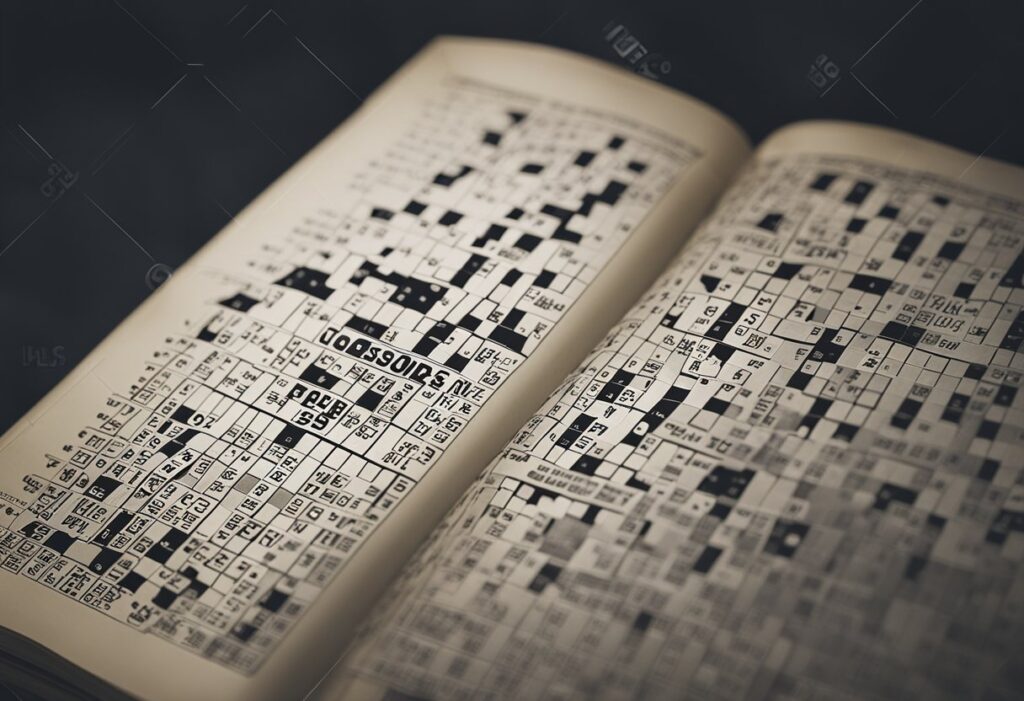Last Updated on February 9, 2024 by JigsawPuzzleGuru
Table of Contents
Tracing the Origins and Evolution of a Beloved Pastime
Crossword puzzles stand as a widely recognized and popular form of word puzzle that has captivated minds for over a century. Crossword puzzle history is fascinating! The concept involves a grid, typically rectangular, where white and black squares are arranged to create a pattern. Participants fill in the white squares with letters, forming words or phrases, by solving clues which lead to the answers. This form of puzzle challenges both the vocabulary and the ingenuity of the solver, offering a unique blend of linguistic exercise and mental stimulation.

The origin of the modern crossword puzzle is often attributed to Arthur Wynne, a journalist from Liverpool who created what is regarded as the first crossword. Published in the New York World newspaper on December 21, 1913, Wynne’s “word-cross” puzzle debuted in the ‘Fun’ section and featured a diamond-shaped grid with numbered squares and clues. The name of this new puzzle quickly became “crossword,” and it wasn’t long before its popularity soared, leading to the creation of dedicated puzzle books and the inclusion of crosswords in newspapers across the world.
As crosswords gained prominence, the style and complexity of the puzzles evolved. The original diamond grids transformed into the familiar square shape, and the rules of symmetry began to dictate the placement of the black squares within the grid. This evolution allowed for a greater variety of puzzle designs and increased the challenge for solvers. Meanwhile, the role of the clue in crosswords became an art form in itself, with constructors developing a wide array of clue types ranging from direct synonyms to complex wordplay. Crossword puzzles continue to engage millions of enthusiasts, ensuring their place in the annals of crossword puzzle history.
Origins and Evolution

The history of crossword puzzles is rich with evolution, marked by key figures and pivotal moments that have shaped the puzzle into what it is today. From its early creation to its rise in newspapers and its status as a staple of modern digital entertainment, the story of the crossword is one of innovation and enduring appeal.
Early Innovations and Key Figures
The precursor to the modern crossword puzzle appeared in Italy with Giuseppe Airoldi’s “word-square” in “Il Secolo Illustrato della Domenica” in the late 19th century. However, it was Arthur Wynne, a journalist from England living in America, who is credited with creating the first crossword puzzle as we know it. Published in the New York World on December 21, 1913, Wynne’s “word-cross” captured the public’s attention. Renamed “cross-word puzzle” due to a typesetting error, its popularity only grew from there, especially during and after World War I.
The Golden Age and Expansion
The 1920s witnessed an explosion in crossword popularity, especially in America. Daily newspapers across the nation began to feature these puzzles. The craze reached its zenith with the publication of crossword books, including the first by Simon and Schuster in 1924. American newspapers, specifically The New York Times, played a monumental role in elevating the puzzle’s status.
Modern Developments
Modern crossword puzzles exhibit a range of styles, with the New York Times crossword remaining a distinguished benchmark for the form, under editors including Margaret Petherbridge Farrar, Will Weng, Eugene T. Maleska, and Will Shortz. Advances in digital technology have brought crosswords online, catering to a broader audience and offering interactive experiences.
International Variations
Crossword puzzles have taken root internationally, adopting unique flavors. British crosswords tend to be cryptic, full of anagrams and wordplay, exemplified by the Times of London. Across Europe, from Paris to Great Britain, variations reflect the linguistic and cultural diversity.
Cultural Impact
Crosswords have become an intrinsic part of global culture, often regarded as a daily ritual for many. The puzzle has permeated through various media, from children’s puzzle books to sophisticated adult challenges in magazines and newspapers.
Design and Structure
Crosswords follow a grid of white and black squares, their size and the ratio of black to white squares varying by difficulty. In addition, standard features include a symmetrical design, with clues provided for both horizontal and vertical entries—the interlock of which creates the flow of the puzzle.
Famous Puzzles and Puzzlemakers
Iconic constructors like Margaret Farrar, Will Shortz, and Stephen Sondheim have all contributed to the art. Noteworthy puzzles include the New York Times‘ election day puzzle and the Boston Globe‘s “Double Diamond Puzzles” by Peter Sherman.
Competitive Crosswording
The American Crossword Puzzle Tournament showcases the best solvers, with increasing difficulty levels and a variety of puzzle styles. Hosted by Will Shortz, this competition highlights the skill of speed and precision in solving crosswords.
Crossword in Education and Mental Exercise
With benefits ranging from vocabulary enhancement to mental exercise, crosswords are used in education and cognitive health. They present an enjoyable way to test one’s language and problem-solving skills, providing fun and educational value.
Crossword Puzzle Books and Syndication
Publishers like Simon and Schuster have grown the visibility of crosswords with books and periodicals. Syndication in daily and weekly American newspapers has made them a daily habit, bringing puzzles to the breakfast table and commutes of millions.
Language and Clues
The language of crosswords involves a mix of straightforward definitions, cryptic clues like anagrams, puns, or code words. Constructors create a dance of wordplay, using clue styles that can vary widely in terms of language and complexity, challenging the solver to think in different, often-unexpected ways.
Evolution of the Crossword Puzzle
The crossword puzzle’s journey can be traced from simple word squares to a worldwide phenomenon with countless variations, deeply embedded in social and cultural practices.
From Word Squares to Crosswords
The humble beginnings of the crossword can be traced back to the late 19th century, where the earliest form known as the word square appeared. Giuseppe Airoldi is often credited with an early innovation; in 1890, he crafted a four-by-four grid with clues in an Italian magazine titled Il Secolo XIX. However, it wasn’t until 1913 that journalist Arthur Wynne transformed Airoldi’s concept into what would be recognized as the first crossword puzzle. Wynne’s “word-cross puzzle,” published in the New York World on December 21, 1913, was a diamond-shaped puzzle with numbered squares and a set of clues.
The Rise in American Popularity
Crosswords began to captivate America in the 1920s, triggering a nationwide craze. The renaming from “word-cross” to “crossword” happened as the puzzles grew in popularity and complexity. Moreover, newspapers such as the New York World continued to print these puzzles, and their immense popularity spurred many other publications to include them as well. Interestingly, The New York Times initially resisted this trend, believing crosswords to be a passing fad, but eventually gave in and published their first crossword in 1942.
Modern Day Crosswords
The modern crossword has become a staple of daily life for many. The New York Times crossword is one of the most famous examples. It is known for its increasing difficulty throughout the week, with the Monday puzzles being the easiest and Saturday’s the hardest. The American Crossword Puzzle Tournament has an annual event established in 1978. The event tests the skill of crossword enthusiasts and has heightened the competitive aspect of crossword solving.
Technical Developments and Variants
In addition to traditional crosswords, various other configurations such as diagramless puzzles have added to the diversity and challenge of the genre. Also, cryptic crosswords, which offer more complex clues, are a popular variation. Technological advancements have played a notable role, with digital versions of crosswords allowing interactive solving tests and immediate feedback on platforms across the internet.
The crossword puzzle’s evolution is a testament to its adaptability and the enduring fascination with word play. From simple grid-based word games to the prominent puzzles we see today, crosswords have carved out a unique niche in cultures around the world.
